Written testimony: B16-195--Historic Preservation Enhancements and Technical Amendments Act of 2005 (Washington, DC)
The Honorable Linda Cropp
Chairman
City Council of the District of Columbia
Dear Chairman Cropp:
Re: B16-195, Historic Preservation Enhancements and Technical Amendments Act of 2005
I am writing in support of legislation currently before Council, "Historic Preservation Enhancements and Technical Amendments Act of 2005" (B16-195). Due to other commitments, I was unable to testify in person at the hearing, and I am sending this written testimony to you for your consideration on this important matter.
This bill is an important step forward in addressing a number of glaring and evident gaps in historic preservation protections in the City, particularly with regard to authority for regulatory enforcement; including a means to effect enforcement; review of requests to demolish properties eligible for historic designation; and the development of procedures and practices to ensure that various District Government agencies act as appropriate stewards of the historic properties in their asset portfolios.
You may recall that I have testified about many of these issues at Council hearings for oversight and/or appropriations for the Office of Planning, before you in both 2003 and 2004.
I could go on for pages and pages and discuss each of the major provisions in detail, as I did in previous testimonies, but that isn't necessary--many people have testified before you already, including Mr. Tersh Boasberg, chair of the Historic Preservation Review Board, and you have reviewed the report submitted by the Office of Planning, which explains this bill.
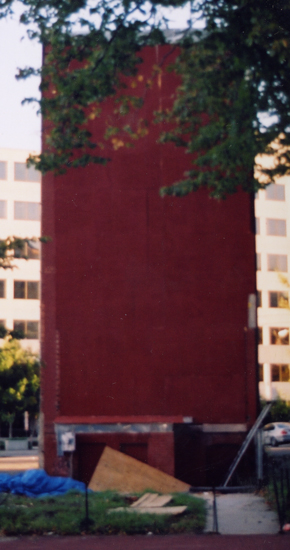
"Altered" or demolished? 400 block of Massachusetts Avenue NW. (Through an alteration permit the facade of this building was ripped off and replaced with plywood sheeting painted brick red.)
Instead, I would like to discuss why historic preservation is particularly important in the District of Columbia, and why thinking of this bill, or preservation generally, as a hindrance to "economic development" fails to recognize the vital importance and centrality of historic preservation to the social, cultural, and economic vitality of the City of Washington.
Certain fortunate center cities such as Washington, DC are "comeback cities," and are on the plus side of the ledger in terms of adding new residents, office and other commercial development, including retail, and as thriving arts, cultural, and tourist destinations.
Yet many of our country's center cities are not experiencing even limited success with urban revitalization, and the character of these cities is changing markedly as city governments seize on a variety of strategies in a futile attempt to arrest the leakage of residents, businesses, and tax revenues in the face of increased needs and costs.
Historic (or Cultural or Heritage) Preservation is increasingly recognized as more than being concerned about recording the past, but is seen as an integral part of the development and extension of urban identity.
Yet, too often, people still have some difficulty in recognizing that history and culture is more than the story of great people like Washington or Lincoln and great buildings like the White House or the Supreme Court.
History and culture is also the story of peoples, neighborhoods, and communities--the whole of history is a mosaic that is incomplete when any one component is ignored, or discarded.
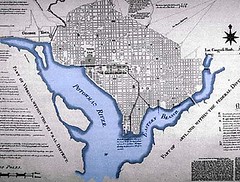 Map of the Federal (L'Enfant) City.
Map of the Federal (L'Enfant) City.In the decades of disinvestment and a continuous leakage of population to the still thriving suburbs of Maryland and Virginia, what kept Washington going was historic residential building stock and the magnificence of the L'Enfant Plan--incorporating grand streets, monuments, and public buildings as well as a plan for compact and walkable residential neighborhoods, with small blocks, a grid pattern of streets, parks, and commercial districts, bringing together people of different incomes and races by providing for a variety of housing types meeting the needs of many.
Preservation of historic buildings and their context has been essential to the stabilization of city neighborhoods such as Capitol Hill and Le Droit Park (where the historic district was created through the efforts of a great many people led by Theresa Brown, a recipient of national awards in recognition of the historic preservation achievements in her neighborhood) through all the years that few people were interested in staying the course, and living in "just another" central city whose heyday was decades past, before the end of World War II.
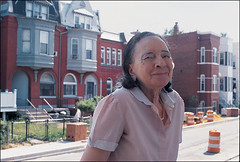 Theresa Brown in LeDroit Park, photo courtesy of the National Trust for Historic Preservation.
Theresa Brown in LeDroit Park, photo courtesy of the National Trust for Historic Preservation.Except maybe for Manhattan and Brooklyn, and perhaps Boston, as few as five years ago, no one thought that cities, including Washington, possessed a second wind.
Historic preservation made it possible:
+ by protecting, enhancing, and extending the city's image and identity, leading to an increase in residents' pride in the city;
+ by providing a destination attractive to visitors, which through "cultural heritage tourism" has become an increasingly important driver of economic development and jobs growth in the city and region; and
+ by providing an engine for (re)development through the restoration, rehabilitation, and reuse of historic buildings and sites throughout the city, integrating historic preservation into the broader development process of the city as a whole.
Historic preservation needs to be thought of as the foundation for virtually all of the non-federal development within the city, linked as it is to residential development, the revitalization of neighborhood commercial districts and portions of downtown such as Seventh Street--which is the longest extant stretch of historic buildings downtown, tourism especially in terms of its growth as a vital engine of the local economy, the development of the arts, culture, and entertainment destinations and districts, and other aspects of the revitalization of the local economy.
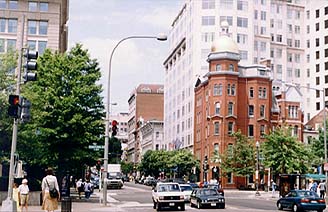
"Mixing it Up"--new and old buildings at Seventh Street and Pennsylvania Avenue NW.
It is essential that all of us in the District committed to the revitalization and repopulation of our great city possess a nuanced understanding about the primacy of authenticity and historic capital and assets-- historic buildings, sites and landscapes; independent businesses; real experiences; unique community history -- as the basic building blocks of the community revitalization strategy for the District of Columbia.
Remaking the city over to be like the suburbs is not what an asset-based community economic development strategy is about. Trying to outmall the mall will never work.
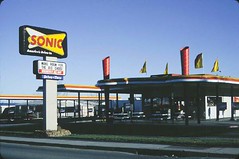 Typical strip development in the suburbs.
Typical strip development in the suburbs.Historic preservation is the heart and soul of our city's competitive advantage--what marketers call (the city's) unique selling proposition. It is not a matter of forcing people "to jump through 100 hoops." Historic preservation is the foundation of the only possible long term economic development strategy that the District Government can sustain.
Urban "renewal" didn't, hasn't, and won't work.
Passing Bill 16-195, Historic Preservation Enhancements and Technical Amendments Act of 2005" ensures that this is recognized by residents, city agencies, local officials, developers, and other stakeholders, and ensures that the District's competitive advantage will be preserved and extended in the 21st century.
Thank you for your consideration.
cc: Members of the City Council of the District of Columbia
Carol Schwartz (At Large)
David Catania (At Large)
Phil Mendelson (At Large)
Kwame Brown (At Large)
Jim Graham (Ward 1)
Jack Evans (Ward 2)
Kathy Patterson (Ward 3)
Adrian Genty (Ward 4)
Vincent Orange (Ward 5)
Sharon Ambrose (Ward 6)
Vincent Gray (Ward 7)
Marion Barry (Ward 8)



0 Comments:
Post a Comment
<< Home